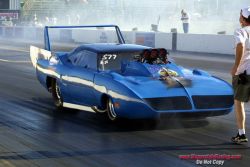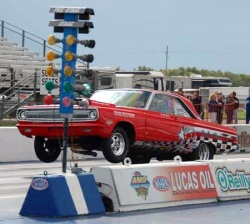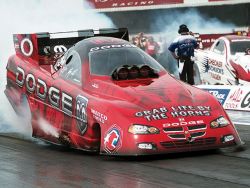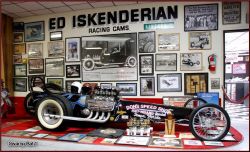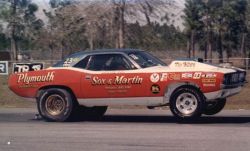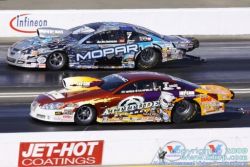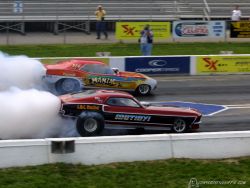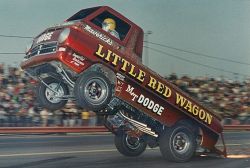Difference between revisions of "Drag racing"
Old Hippie (talk | contribs) (New page: looking for someone to get the ball rolling on this topic == Intro == == References == == Related Links == Category:Drag Racing) |
Old Hippie (talk | contribs) |
||
| (34 intermediate revisions by 3 users not shown) | |||
| Line 1: | Line 1: | ||
| − | + | {{Template:Openx}} | |
| − | == | + | |
| + | [[Image:Mmw46.jpg|thumb|250px|[[Texas Big Bird]] is an example of an [[IHRA]] [[ProMod]]]] | ||
| + | [[Image:Ls2007a.jpg|thumb|250px|[[Big Red Ram]] is and example of a [[NSS]] car in [[NMCA]]]] | ||
| + | [[Image:Dodge funny car.jpg|thumb|250px|[[Dodge]] [[Funny Car]] in [[NHRA]] circa 2003]] | ||
| + | [[Image:Swamp rat-1.jpg|thumb|250px|[[Don Garlits]]' [[Swamp Rat]] I is an example of a [[Dragster]] that ran in the late 50s]] | ||
| + | [[Image:Gassers.jpg|thumb|250px|A pair of [[Gassers]], like those made popular in the 50s]] | ||
| + | [[Image:Top fuel dragster.jpg|thumb|250px|Tony Schumacher's [[Top Fuel]] Dragster at night]] | ||
| + | [[Image:Soxmartinprostock.jpg|thumb|250px|[[Sox & Martin]] [[Pro Stock]] [[Cuda]] in 1970]] | ||
| + | [[Image:Prostock2010.jpg|thumb|250px|Pro Stock Racing in 2010]] | ||
| + | [[Image:Nostfunnycar.jpg|thumb|250px|Funny Cars of the 70s]] | ||
| + | [[Image:Mojets2.jpg|thumb|250px|First Race of 4 [[Jet Cars]] at Once - [[Zmax]] 2009]] | ||
| + | [[Image:LittleRedWagon2a.jpg|thumb|250px|[[Bill 'Maverick' Golden]]'s [[Wheel Standing]] [[Lil Red Wagon]]]] | ||
| + | [[Image:9375TimeSlipMemphis10-08.jpg|thumb|250px|Time Slip of a pass]] | ||
| + | |||
| + | Drag racing is a competition in which vehicles compete to be the first to cross a set finish line, usually from a standing start, and in a straight line. First gaining popularity in the USA after World War II, the sport steadily grew in popularity and spread across the globe. | ||
| + | |||
| + | == The Basics of Drag Racing == | ||
| + | |||
| + | Generally, you will attend a drag race as either a [[spectator]], or part of a [[drag race team]]. Each will have their own entrance, although drag racing is one of those rare sports where the spectators are given unfettered access to the pits, and are allowed to visit with and observe the race teams. Racing is dangerous to the competitors, team members, and even the spectators. At a [[NHRA]] race in Phoenix on February 20, 2010, a tire came off the [[Top Fuel]] dragster of [[Antron Brown]], and bounced over the fence striking and killing a woman pushing a wheel chair. As such, everyone will waive Liability against the track as they enter it. This is usually done by signing a waiver sheet as you enter the pits, or a notification on the reverse of a spectator ticket if you enter through the spectator gate. | ||
| + | |||
| + | === [[The Pits]] === | ||
| + | |||
| + | The "pits" is the area of the track facility where the driver and crew work on their cars. For small events at large tracks -- both spectator and crew might enter and park in the pits. During larger events, or at smaller tracks, only the race teams enter through the pit gate and the speculators park in a lot away from the pit and enter through a spectator gate. Spectators do still have the ability to the walk through the pits and visit with the teams. | ||
| + | |||
| + | An individual team pit, is usually large enough for the team to have two spaces side by side. One for the hauler and one for the race car. At crowded events, some classes of cars will only receive one space for their pit -- and will need to work on their car behind their trailer. | ||
| + | |||
| + | The pits are often dangerous as you have a combination of race cars returning to their pit and spectators wandering through the pits without paying attention to where they are walking. Making it worse, there are often unattended children; scooters; golfcarts; (and too often these children driving golf carts or riding bikes and scooters) cars being pulled to the staging area; or cars returning from their pass. It is very congested with a bad combination of people in a big hurry, and people not in any hurry at all. Both need to pay attention of what is going on around them. | ||
| + | |||
| + | The pits will usually have a place to dump used oil, and buy race gas. | ||
| + | |||
| + | === Safety === | ||
| + | |||
| + | As previously stated, drag racing is a very dangerous sport. To minimize the chances of injury or death, there are many safety rules for the car, driver, team, and tracks. | ||
| + | |||
| + | ==== Driver Safety ==== | ||
| + | |||
| + | A drag race driver must show the necessary skills and competence to be of a minimal danger to himself and others. [[Junior Dragsters]] excluded, most sanctioned tracks require the drag race driver to process a current and valid state driver's license. Generally, if his privileges have been suspended on the street -- it will also be suspended at the track. | ||
| + | |||
| + | Drivers under 18 with a valid state driver's license, will need to have a parent or legal guardian sign a waiver and accepting responsibility for their child/ward. Often this waiver will be good for the calendar year. This waiver is usually available at either the [[Control Tower]], or at tech inspection. | ||
| + | |||
| + | Drivers going faster than 9.99 seconds in the quarter are required to have a current [[Competition License]] for the [[sanctioning body]] that sanctions the track or event. To obtain a license, the applicant must pass a rigorous physical examination (more rigorous with a heart stress exam after the age of 55), and then demonstrate his ability with six "Licensing Passes" in the presence of three other licensed racers. Racing is dangerous to both the driver and others on the track, especially at speeds faster than 10 seconds -- so it is advisable for the driver to take a professional 2-day class specific to the type of car ([[Dragster]] or [[Doorslammer]]) he will be racing, at an acceptable drag racing school. Too often racers put their licensed friends in the position of pencil-whipping their acknowledgment of the license applicant's abilities. Drag Racing Schools will ensure that you obtain and prove the necessary skills -- or they will not sign off on your license. The Competition License expires two years after the date of the submitted physical, and will require another physical exam as part of the renewal process. There are different levels of licenses based on how quick you go, and the type fuel that you use. | ||
| + | |||
| + | Based on the level of racing, the driver is required to wear a certain level of safety equipment. At the slowest and most basic level of racing, the driver is required to wear long pants, leather shoes, and a long sleeved shirt. A little faster of a car will require a [[SFI]] certified [[helmet]], and a single layer fire jacket. As the car goes quicker and/or more volatile fuels are used, increased levels of fire resistant driving suits, shoes, gloves, helmets, and neck braces are required. This driver's equipment is rated with a certification number by the [[SFI Foundation, Inc.]], and this certification number and manufacturer date is affixed to the equipment for the track's tech inspectors to verify. Most all of this equipment has a SFI designated life, and the tech inspector will check the date along with the certification number for your class of racing. It is the driver's responsibility to stay abreast of changes in equipment requirements for his racing -- and when his equipment has expired. The track is suppose to not allow the driver to race if he has improper or out of date safety equipment. | ||
| + | |||
| + | ==== Vehicle Safety ==== | ||
| + | |||
| + | There are certain levels of safety requirements on a vehicle, based on how quick it will be running. At its most basic level, the vehicle must have [[seat belts]], be in a safe condition, not have a long run of a rubber fuel line, not use anti-freeze, and not be leaking any fluids. As a vehicle goes quicker or is modified, the rules get tougher. [[Roll bars]], [[certified cages]], [[drive-shaft loops]], [[battery cutoff]], [[Certified Chassis]], [[safety harness]], [[overflow can]]s, and [[window nets]] will be required. [[Engine Diapers]] to contain fluid leaks/spills; [[transmission shields]] and [[blower restraints]] to contain explosions; and components like [[harmonic balancer]]s that are SFI certified to prove they can take the extremely high [[RPM]]s required at various levels. Most of this equipment must be [[SFI]] certified -- and will expire at some point after the [[manufacturer date]]. | ||
| + | |||
| + | It is the responsibility of the driver to know what equipment is required for his situation, and that it is in date. It is the responsibility of the the [[technical inspector]] to not allow any car to run, which has not met the safety standard set for the track. | ||
| + | |||
| + | ==== Crew Safety ==== | ||
| + | |||
| + | Based on the type of car, and the track's rules -- some crew may be allowed in the staging lanes, and to help stage the car. There is always some element of danger in these areas, and the crew needs to take proper precautions. Many tracks and/or events will require the crew member to meet with a track official and obtain a crew bracelet. | ||
| + | |||
| + | ==== Track Safety ==== | ||
| + | |||
| + | Tracks are responsible for providing a safe surface that is properly prepared, and free of unnecessary danger. Frankly some tracks do a better job than others. There are quite a few tracks with dangerous transitions, dips, obstructions, walls, shut downs, etc... or are improperly prepared for the faster cars to safely make a pass on. | ||
| + | |||
| + | The track manager is required to ensure that the lanes are properly cleaned before any car goes down it. That's to say if the track is suppose to be dry (from rain, or leaking fluids) and free of anything that shouldn't be on it -- such as blowing dirt or a car part. The track will have equipment required to scrape, sweep or burn off what shouldn't be on the racing surface; and to apply an adhesion substance, such as [[VHT]], which will make the track surface stickier. Obviously a greasy or slippery track is a dangerous track. | ||
| + | |||
| + | The track is required to have an ambulance and qualified medical assistance at the side of the track, able to immediately respond to medical emergencies such as crashed and fires, and no one is allowed to make a pass if they are not present. Likewise, the track is required to have the proper ability to immediately respond to car fires. | ||
| + | |||
| + | === [[Tech In]] === | ||
| + | |||
| + | Once a race car has been unloaded from the trailer, the car; the driver's license; and the driver's safety equipment are taken to the track's [[tech inspector]], along with the completed [[tech card]]. There a safety inspection for the required equipment, certifications, and expiration dates are conducted. If the car and driver has passed the inspection, the tech card is sent to the control tower and the car entered into the track's computer for the event. Often there will be some identifying mark made on the car, and a driver's bracelet issued to the driver. | ||
| + | |||
| + | === [[Staging Lanes]] === | ||
| + | |||
| + | The staging lanes are a series of lanes (usually eight), just prior to the entrance to the actual drag strip. This is where different classes of cars are called to and paired up for their next pass. There will usually be two of three classes of cars waiting in the lanes, so that there will be continuous racing action from class to class. | ||
| + | |||
| + | === [[Burnout]] === | ||
| + | |||
| + | Prior to a car making its pass, it does a burn out to clean off trash picked up and on the soft tires; and to further soften the rubber for better traction. Cars with [[slicks]] will usually drive through the [[water box]] for the lubrication the slicks need to get them quickly spinning. Cars with [[street tires]] will most often drive around the water, as their tread will collect and retain water after the burn out; dripping to the track at launch and causing wheel spin. With exception of the fastest classes -- the entire burn out must be accomplished without crossing the starting [[staging beams]]; as crossing the line, backing up, and then moving up to stage causes an un-necessary delay in the racing action. | ||
| + | |||
| + | To accomplish this burnout in a short space, many race cars are equipped with a device called a [[line-lock]]. A line lock is a solenoid in the middle of the front brake's fluid line, that will hold the pressure to the front brakes when a button is pushed. This allows the rear wheels (assuming a rear-wheel drive vehicle) to spin while the front brakes hold the car in place. | ||
| + | |||
| + | Cars which are 7-seconds and faster won't have a line lock -- as their front brakes would never be able to hold a car with that much power and that wide of slicks. They are allowed to go past the beams for their burnouts -- as the the massive amounts of rubber they leave on the track is also useful in reducing wheel spin during the pass. | ||
| + | |||
| + | If you are going to have your burnout take you past the tree, you had better be able to rip off a 7-second or faster pass or someone will come to talk to you. | ||
| + | |||
| + | Generally after a burnout, and before staging -- the car will rev the motor to 6000-7000 RPM for a second while in neutral. This is done to clear the carburetors from bogging, and clean the plugs from fouling. | ||
| + | |||
| + | === [[Pre-Stage]] === | ||
| + | |||
| + | Drivers will have wanted to conduct their entire burnout far enough back in the lane to give them enough room to get their car aimed straight as they pull up to the pre-staging beams. As they move up towards the beams, they will be looking to line up in [[the groove]], which is a narrow track of built up rubber on the most worn part of the track. This groove is the stickiest part of the drag strip, and the safest place to have their car's tires running in. Since most cars have the driver offset to the left of center, many will not be lining up their car as straight as they think they are if they are looking just ahead of the car. Those standing in back of the car will notice it is angled a little to the right. This will necessitate a correction to the left after they launch. Those who line their cars up perfectly straight have most likely been trained to line up in the groove while looking far down the track for a more accurate angle. | ||
| + | |||
| + | The first set of [[beams]] that the front tires break, are the pre-stage beams. Breaking that set of beams will turn on the top set of yellow light bulbs on the [[tree]] in the car's lane. [[Courtesy Staging]] has both cars light the pre-stage lights, before any of the cars moves up to break the next set of of beams. A driver who both pre-stages and stages before his competitor pre-stages is considered to be either rude, ignorant, or both. | ||
| + | |||
| + | === [[Stage]] === | ||
| + | |||
| + | Once both cars have pre-staged, they will ever so slowly inch forward until the next set of yellow bulbs in their lane light. At this point they will be staged. Some stop immediately when they light flicker on, which is referred to as [[Shallow Staging]]. The benefit of shallow staging is more consistent [[Reaction Times]] from being in exactly the same spot every time. Others like to [[Deep Stage]], which has them move up slightly after staging. The benefit of this is a higher top end speed -- but the drawback is not consistently being in the exact same spot for a consistent reaction time, and the possibility of going to far causing a false-start. | ||
| + | |||
| + | === [[Launch]] === | ||
| + | |||
| + | After staging, a car is ready to launch. How they launch is dependent on their type of transmission. A car with a [[transbrake automatic transmission]] will have a button that when pushed has the car in reverse and first gear at the same time, holding the car at the line until the button is released. | ||
| + | |||
| + | A [[foot brake automatic transmission]] will have the left foot on the brake pedal while bringing the car's RPMs up to the desired level for launching the car. | ||
| + | |||
| + | A manual transmission car will have the car launched with dumping the clutch, while at the same time releasing the linelock used to keep the car from rolling. | ||
| + | |||
| + | There are two different timings used on a tree, based on the class of racing. A [[Pro Tree]] will have the all three of the amber burbs light and then the green bulb to light in 4/10 of a second later. A [[Sportsman Tree]] will have the the three amber bulbs count to green in 5/10 of a second. | ||
| + | |||
| + | Because the time required for the brain to process what the eye sees, and then command the muscles to react properly -- anticipation is required. If the driver waits until he actually sees the the green light -- he will be too late for a good reaction time. For a better reaction time, he will need to actually make the move to leave before the green bulb lights, by the amount of time his brain processes what it sees and reacts. However, being too quick will have the car leave too early -- known as a [[Red Light]], immediately ending the race. If both drivers were to "Red Light", the driver who made the first false start will have lost, as the race will have ended before the second driver was to have red lit. | ||
| + | |||
| + | === [[Drag Strip]] === | ||
| + | |||
| + | |||
| + | === [[60']] === | ||
| + | |||
| + | The 60' Measurement is the time it took for the car to move from a dead stop to a set of beams 60' up the track. When compared to the car's optimum time for that measurement, the team will know if the launch RPM was proper, and/or if the car spun the tires. This measurement is often referred to as the car's [[short time]]. | ||
| + | |||
| + | === [[330']] === | ||
| + | |||
| + | The 330' measurement is used to judge if there was wheel spin or a miss-shift. | ||
| + | |||
| + | === [[660']] === | ||
| + | |||
| + | The 660' measurement time and speeds give the team an indication how the car performed in the first 1/8 mile of the race. many tracks and races are now 1/8 mile -- as it is easier of the car's parts, and cheaper for the track to build and maintain. | ||
| + | |||
| + | === [[1000']] === | ||
| + | |||
| + | The 1000' measurement gives the team and indication of how the car ran in that segment of the race. Recently Scot Kalitta was killed when his top fuel dragster couldn't stop quick enough, and since then the NHRA has shortened races for Top Fuel cars to 1000'. | ||
| + | |||
| + | === [[1320']] === | ||
| + | |||
| + | The time given at the 1320 (1/4 mile) is going to be the [[ET]] (Elapsed Time) of the pass, along with the speed. This ET added to the RT is called the [[package]], and it is compared to the "Package" of the competitor. In a [[match race]], the car with the lowest package without otherwise being disqualified (Red lit, crossed the line, brushed the wall, ...), wins the round. | ||
| + | |||
| + | === [[Shut Down]] === | ||
| + | |||
| + | This is the area of the track after the finish line where the car slows down before turning off to the return road. Cars not slowing down enough before the turn off have a [[sand trap]] at the end of the track, which will slow them down quickly. | ||
| + | |||
| + | === [[Turn Off]] === | ||
| + | |||
| + | The turn off is one of the exits from the drag strip to the return road. | ||
| + | |||
| + | === [[Return Road]] === | ||
| + | |||
| + | The "Return Road" is the road, usually running parallel to the drag strip, that allows the car to return to their teams' pit. | ||
| + | |||
| + | === [[Ticket Shack]] === | ||
| + | |||
| + | The "Ticket Shack" is a small building on the return road that a driver drives by, and can pick up a time slip that recaps the run he just made. | ||
| + | |||
| + | == Major [[Sanctioning Bodies]] of Drag Racing == | ||
| + | * [[NHRA]] | ||
| + | * [[IHRA]] | ||
| + | * [[AHRA]] | ||
| + | * [[NMCA]] | ||
| + | * [[NMRA]] | ||
| + | |||
| + | == [[Drag Racing Schools]] == | ||
| + | There are a number of Drag Racing Schools that instruct racers and help them obtain their license, and improve their skills to race professionally, and/or move up to another class. Below are the two most popular drag racing schools. | ||
| + | |||
| + | * [[Frank Hawley Drag Racing School]] | ||
| + | * [[Roy Hill's Drag Racing School]] | ||
| + | |||
| + | == Types of Drag Racing Cars == | ||
| + | |||
| + | {{Template:Underconstruction}} | ||
| + | |||
| + | === [[Door Slammers]] === | ||
| + | |||
| + | ==== [[ProMod]] ==== | ||
| + | |||
| + | ==== [[Super Comp]] ==== | ||
| + | |||
| + | ==== [[Stock]] / [[Super Stock]] ==== | ||
| + | |||
| + | ==== [[Gassers]] ==== | ||
| + | |||
| + | === Other Drag Cars === | ||
| + | |||
| + | ==== [[Dragsters]] ==== | ||
| + | |||
| + | ==== [[Altereds]] ==== | ||
| + | |||
| + | ==== [[Funny Cars]] ==== | ||
| + | |||
| + | ==== [[Jet Cars]] ==== | ||
| + | |||
| + | == [[Fuel Types]] == | ||
| + | |||
| + | === [[Nitro]] / [[Top Fuel]] === | ||
| + | |||
| + | === [[Alcohol]] / [[Methanol]] === | ||
| + | |||
| + | === [[Race Gas]] === | ||
| + | |||
| + | There are various octane levels of race gas -- ranging from 100 [[Octane]] to 123 Octane. Some of these race fuels are unleaded, while most of the higher octane fuels contain [[lead]]. Some of these fuels are [[oxygenated]]. Most race gas is sold in 55 gallon drums -- although some can be bought in 5 gallon cans, or even pumped at many tracks. | ||
| + | |||
| + | === [[Pump Gas]] === | ||
| + | |||
| + | Pump gas is generally referred to as [[Unleaded Gas]] with an [[octane]] rating of not higher than 93, which is generally sold to fuel the street cars of the general public. It is most often dispensed in [[gasoline pumps]] at gas stations and convenience stores, thus the reference "Pump Gas". Most recently, a popular form of drag racing is with vehicles fueled by pump gas, requiring a lower [[compression]] [[motor]] than is typically found in all out race cars. Many of these "[[Street Racing]]" classes will have the car first be part of an off track "Road Trip" of 25 to 50 miles on pump gas, to prove it's [[streetability]], then immediately make it's pass down the [[drag strip]] on pump gas -- without making any adjustments to the car. | ||
| + | |||
| + | == [[Control Tower]] == | ||
| + | |||
| + | The control tower is typically at or around the starting line. It generally has a crew that over see's, announces, and manages all of the track's / event's functions. | ||
| + | |||
| + | == Types of Passes == | ||
| + | |||
| + | Runs, or passes, are made for different reasons. Below is a brief explanation of some of the different types of passes. | ||
| + | |||
| + | === [[Test & Tune]] === | ||
| + | |||
| + | Test and Tune runs are made prior to an event to work out the bugs and make adjustments to the car. | ||
| + | |||
| + | === [[Time Trials]] === | ||
| + | |||
| + | At an event, drivers are often given a chance to make a pass or two to see how their car runs at that particular track's elevation, and the current weather conditions. This gives the team a chance to make a few last minute adjustments, such as [[carburetor Jetting]], prior to qualifying. | ||
| + | |||
| + | === [[Qualifying]] === | ||
| + | |||
| + | At many competitions, the number of cars in a given class may be limited to 16 or 32. Qualifying Runs are timed passes used to set the number of cars in a class, and to determine the [[competition ladder]] for Eliminations. | ||
| + | |||
| + | === [[Eliminations]] === | ||
| + | |||
| + | Elimination passes are the actual event's competition. Competitors are paired against each other on the competition ladder, based on their previous qualifying passes. The winners of each round will meet each other in the next round, and the losers of the round are "Eliminated". As an example: if sixteen competitors meet in the first round, there will be eight left to compete in the second round. Those eight will meet in the [[Quarter Finals]], and the four winners of that round will meet in the [[Semi-Finals]]. The two winners of the "semis" will meet in the [[finals]], and the winner of that last round will be the winner of the race. | ||
| + | |||
| + | === [[Exhibition Pass]] === | ||
| + | |||
| + | An "Exhibition Pass" is generally a non-competition pass of popular race car, purely for the pleasure of the spectators. [[Wheelstanders]] are an example of a car that often make an Exhibition Pass as a crowd pleaser. | ||
| + | |||
| + | === [[Licensing Pass]] === | ||
| + | |||
| + | A "Licensing Pass" is one of the passes required to be made in the presence of those needing to sign off on the competence of the license applicant. | ||
| + | |||
| + | == [[Time Slip]] == | ||
| + | |||
| + | At the end of a pass, there is a time slip printed and given to the drivers, as the return to their pit. This slip recaps the pass by giving the time and speeds at different portions of the track. | ||
== References == | == References == | ||
| Line 7: | Line 235: | ||
== Related Links == | == Related Links == | ||
| − | [[Category: | + | * [http://www.frankhawley.com/ Frank Hawley Drag Racing School] |
| + | * [https://www.screaminwoody.com Screamin Woody] | ||
| + | * [https://www.texasthugracing.com Texas Thug Racing] | ||
| + | * [https://www.moparstyleracing.com MoparStyle Racing] | ||
| + | * [http://royhillsdragracingschool.com/ Roy Hill's Drag Racing School] | ||
| + | |||
| + | {{Template:BottomWikiNSS}} | ||
| + | |||
| + | [[Category:Racing]] | ||
| + | [[Category:Whitepaper]] | ||
Latest revision as of 18:16, 9 May 2023
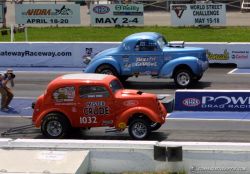
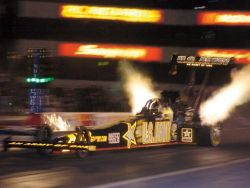
Drag racing is a competition in which vehicles compete to be the first to cross a set finish line, usually from a standing start, and in a straight line. First gaining popularity in the USA after World War II, the sport steadily grew in popularity and spread across the globe.
Contents
- 1 The Basics of Drag Racing
- 2 Major Sanctioning Bodies of Drag Racing
- 3 Drag Racing Schools
- 4 Types of Drag Racing Cars
- 5 Fuel Types
- 6 Control Tower
- 7 Types of Passes
- 8 Time Slip
- 9 References
- 10 Related Links
The Basics of Drag Racing
Generally, you will attend a drag race as either a spectator, or part of a drag race team. Each will have their own entrance, although drag racing is one of those rare sports where the spectators are given unfettered access to the pits, and are allowed to visit with and observe the race teams. Racing is dangerous to the competitors, team members, and even the spectators. At a NHRA race in Phoenix on February 20, 2010, a tire came off the Top Fuel dragster of Antron Brown, and bounced over the fence striking and killing a woman pushing a wheel chair. As such, everyone will waive Liability against the track as they enter it. This is usually done by signing a waiver sheet as you enter the pits, or a notification on the reverse of a spectator ticket if you enter through the spectator gate.
The Pits
The "pits" is the area of the track facility where the driver and crew work on their cars. For small events at large tracks -- both spectator and crew might enter and park in the pits. During larger events, or at smaller tracks, only the race teams enter through the pit gate and the speculators park in a lot away from the pit and enter through a spectator gate. Spectators do still have the ability to the walk through the pits and visit with the teams.
An individual team pit, is usually large enough for the team to have two spaces side by side. One for the hauler and one for the race car. At crowded events, some classes of cars will only receive one space for their pit -- and will need to work on their car behind their trailer.
The pits are often dangerous as you have a combination of race cars returning to their pit and spectators wandering through the pits without paying attention to where they are walking. Making it worse, there are often unattended children; scooters; golfcarts; (and too often these children driving golf carts or riding bikes and scooters) cars being pulled to the staging area; or cars returning from their pass. It is very congested with a bad combination of people in a big hurry, and people not in any hurry at all. Both need to pay attention of what is going on around them.
The pits will usually have a place to dump used oil, and buy race gas.
Safety
As previously stated, drag racing is a very dangerous sport. To minimize the chances of injury or death, there are many safety rules for the car, driver, team, and tracks.
Driver Safety
A drag race driver must show the necessary skills and competence to be of a minimal danger to himself and others. Junior Dragsters excluded, most sanctioned tracks require the drag race driver to process a current and valid state driver's license. Generally, if his privileges have been suspended on the street -- it will also be suspended at the track.
Drivers under 18 with a valid state driver's license, will need to have a parent or legal guardian sign a waiver and accepting responsibility for their child/ward. Often this waiver will be good for the calendar year. This waiver is usually available at either the Control Tower, or at tech inspection.
Drivers going faster than 9.99 seconds in the quarter are required to have a current Competition License for the sanctioning body that sanctions the track or event. To obtain a license, the applicant must pass a rigorous physical examination (more rigorous with a heart stress exam after the age of 55), and then demonstrate his ability with six "Licensing Passes" in the presence of three other licensed racers. Racing is dangerous to both the driver and others on the track, especially at speeds faster than 10 seconds -- so it is advisable for the driver to take a professional 2-day class specific to the type of car (Dragster or Doorslammer) he will be racing, at an acceptable drag racing school. Too often racers put their licensed friends in the position of pencil-whipping their acknowledgment of the license applicant's abilities. Drag Racing Schools will ensure that you obtain and prove the necessary skills -- or they will not sign off on your license. The Competition License expires two years after the date of the submitted physical, and will require another physical exam as part of the renewal process. There are different levels of licenses based on how quick you go, and the type fuel that you use.
Based on the level of racing, the driver is required to wear a certain level of safety equipment. At the slowest and most basic level of racing, the driver is required to wear long pants, leather shoes, and a long sleeved shirt. A little faster of a car will require a SFI certified helmet, and a single layer fire jacket. As the car goes quicker and/or more volatile fuels are used, increased levels of fire resistant driving suits, shoes, gloves, helmets, and neck braces are required. This driver's equipment is rated with a certification number by the SFI Foundation, Inc., and this certification number and manufacturer date is affixed to the equipment for the track's tech inspectors to verify. Most all of this equipment has a SFI designated life, and the tech inspector will check the date along with the certification number for your class of racing. It is the driver's responsibility to stay abreast of changes in equipment requirements for his racing -- and when his equipment has expired. The track is suppose to not allow the driver to race if he has improper or out of date safety equipment.
Vehicle Safety
There are certain levels of safety requirements on a vehicle, based on how quick it will be running. At its most basic level, the vehicle must have seat belts, be in a safe condition, not have a long run of a rubber fuel line, not use anti-freeze, and not be leaking any fluids. As a vehicle goes quicker or is modified, the rules get tougher. Roll bars, certified cages, drive-shaft loops, battery cutoff, Certified Chassis, safety harness, overflow cans, and window nets will be required. Engine Diapers to contain fluid leaks/spills; transmission shields and blower restraints to contain explosions; and components like harmonic balancers that are SFI certified to prove they can take the extremely high RPMs required at various levels. Most of this equipment must be SFI certified -- and will expire at some point after the manufacturer date.
It is the responsibility of the driver to know what equipment is required for his situation, and that it is in date. It is the responsibility of the the technical inspector to not allow any car to run, which has not met the safety standard set for the track.
Crew Safety
Based on the type of car, and the track's rules -- some crew may be allowed in the staging lanes, and to help stage the car. There is always some element of danger in these areas, and the crew needs to take proper precautions. Many tracks and/or events will require the crew member to meet with a track official and obtain a crew bracelet.
Track Safety
Tracks are responsible for providing a safe surface that is properly prepared, and free of unnecessary danger. Frankly some tracks do a better job than others. There are quite a few tracks with dangerous transitions, dips, obstructions, walls, shut downs, etc... or are improperly prepared for the faster cars to safely make a pass on.
The track manager is required to ensure that the lanes are properly cleaned before any car goes down it. That's to say if the track is suppose to be dry (from rain, or leaking fluids) and free of anything that shouldn't be on it -- such as blowing dirt or a car part. The track will have equipment required to scrape, sweep or burn off what shouldn't be on the racing surface; and to apply an adhesion substance, such as VHT, which will make the track surface stickier. Obviously a greasy or slippery track is a dangerous track.
The track is required to have an ambulance and qualified medical assistance at the side of the track, able to immediately respond to medical emergencies such as crashed and fires, and no one is allowed to make a pass if they are not present. Likewise, the track is required to have the proper ability to immediately respond to car fires.
Tech In
Once a race car has been unloaded from the trailer, the car; the driver's license; and the driver's safety equipment are taken to the track's tech inspector, along with the completed tech card. There a safety inspection for the required equipment, certifications, and expiration dates are conducted. If the car and driver has passed the inspection, the tech card is sent to the control tower and the car entered into the track's computer for the event. Often there will be some identifying mark made on the car, and a driver's bracelet issued to the driver.
Staging Lanes
The staging lanes are a series of lanes (usually eight), just prior to the entrance to the actual drag strip. This is where different classes of cars are called to and paired up for their next pass. There will usually be two of three classes of cars waiting in the lanes, so that there will be continuous racing action from class to class.
Burnout
Prior to a car making its pass, it does a burn out to clean off trash picked up and on the soft tires; and to further soften the rubber for better traction. Cars with slicks will usually drive through the water box for the lubrication the slicks need to get them quickly spinning. Cars with street tires will most often drive around the water, as their tread will collect and retain water after the burn out; dripping to the track at launch and causing wheel spin. With exception of the fastest classes -- the entire burn out must be accomplished without crossing the starting staging beams; as crossing the line, backing up, and then moving up to stage causes an un-necessary delay in the racing action.
To accomplish this burnout in a short space, many race cars are equipped with a device called a line-lock. A line lock is a solenoid in the middle of the front brake's fluid line, that will hold the pressure to the front brakes when a button is pushed. This allows the rear wheels (assuming a rear-wheel drive vehicle) to spin while the front brakes hold the car in place.
Cars which are 7-seconds and faster won't have a line lock -- as their front brakes would never be able to hold a car with that much power and that wide of slicks. They are allowed to go past the beams for their burnouts -- as the the massive amounts of rubber they leave on the track is also useful in reducing wheel spin during the pass.
If you are going to have your burnout take you past the tree, you had better be able to rip off a 7-second or faster pass or someone will come to talk to you.
Generally after a burnout, and before staging -- the car will rev the motor to 6000-7000 RPM for a second while in neutral. This is done to clear the carburetors from bogging, and clean the plugs from fouling.
Pre-Stage
Drivers will have wanted to conduct their entire burnout far enough back in the lane to give them enough room to get their car aimed straight as they pull up to the pre-staging beams. As they move up towards the beams, they will be looking to line up in the groove, which is a narrow track of built up rubber on the most worn part of the track. This groove is the stickiest part of the drag strip, and the safest place to have their car's tires running in. Since most cars have the driver offset to the left of center, many will not be lining up their car as straight as they think they are if they are looking just ahead of the car. Those standing in back of the car will notice it is angled a little to the right. This will necessitate a correction to the left after they launch. Those who line their cars up perfectly straight have most likely been trained to line up in the groove while looking far down the track for a more accurate angle.
The first set of beams that the front tires break, are the pre-stage beams. Breaking that set of beams will turn on the top set of yellow light bulbs on the tree in the car's lane. Courtesy Staging has both cars light the pre-stage lights, before any of the cars moves up to break the next set of of beams. A driver who both pre-stages and stages before his competitor pre-stages is considered to be either rude, ignorant, or both.
Stage
Once both cars have pre-staged, they will ever so slowly inch forward until the next set of yellow bulbs in their lane light. At this point they will be staged. Some stop immediately when they light flicker on, which is referred to as Shallow Staging. The benefit of shallow staging is more consistent Reaction Times from being in exactly the same spot every time. Others like to Deep Stage, which has them move up slightly after staging. The benefit of this is a higher top end speed -- but the drawback is not consistently being in the exact same spot for a consistent reaction time, and the possibility of going to far causing a false-start.
Launch
After staging, a car is ready to launch. How they launch is dependent on their type of transmission. A car with a transbrake automatic transmission will have a button that when pushed has the car in reverse and first gear at the same time, holding the car at the line until the button is released.
A foot brake automatic transmission will have the left foot on the brake pedal while bringing the car's RPMs up to the desired level for launching the car.
A manual transmission car will have the car launched with dumping the clutch, while at the same time releasing the linelock used to keep the car from rolling.
There are two different timings used on a tree, based on the class of racing. A Pro Tree will have the all three of the amber burbs light and then the green bulb to light in 4/10 of a second later. A Sportsman Tree will have the the three amber bulbs count to green in 5/10 of a second.
Because the time required for the brain to process what the eye sees, and then command the muscles to react properly -- anticipation is required. If the driver waits until he actually sees the the green light -- he will be too late for a good reaction time. For a better reaction time, he will need to actually make the move to leave before the green bulb lights, by the amount of time his brain processes what it sees and reacts. However, being too quick will have the car leave too early -- known as a Red Light, immediately ending the race. If both drivers were to "Red Light", the driver who made the first false start will have lost, as the race will have ended before the second driver was to have red lit.
Drag Strip
60'
The 60' Measurement is the time it took for the car to move from a dead stop to a set of beams 60' up the track. When compared to the car's optimum time for that measurement, the team will know if the launch RPM was proper, and/or if the car spun the tires. This measurement is often referred to as the car's short time.
330'
The 330' measurement is used to judge if there was wheel spin or a miss-shift.
660'
The 660' measurement time and speeds give the team an indication how the car performed in the first 1/8 mile of the race. many tracks and races are now 1/8 mile -- as it is easier of the car's parts, and cheaper for the track to build and maintain.
1000'
The 1000' measurement gives the team and indication of how the car ran in that segment of the race. Recently Scot Kalitta was killed when his top fuel dragster couldn't stop quick enough, and since then the NHRA has shortened races for Top Fuel cars to 1000'.
1320'
The time given at the 1320 (1/4 mile) is going to be the ET (Elapsed Time) of the pass, along with the speed. This ET added to the RT is called the package, and it is compared to the "Package" of the competitor. In a match race, the car with the lowest package without otherwise being disqualified (Red lit, crossed the line, brushed the wall, ...), wins the round.
Shut Down
This is the area of the track after the finish line where the car slows down before turning off to the return road. Cars not slowing down enough before the turn off have a sand trap at the end of the track, which will slow them down quickly.
Turn Off
The turn off is one of the exits from the drag strip to the return road.
Return Road
The "Return Road" is the road, usually running parallel to the drag strip, that allows the car to return to their teams' pit.
Ticket Shack
The "Ticket Shack" is a small building on the return road that a driver drives by, and can pick up a time slip that recaps the run he just made.
Major Sanctioning Bodies of Drag Racing
Drag Racing Schools
There are a number of Drag Racing Schools that instruct racers and help them obtain their license, and improve their skills to race professionally, and/or move up to another class. Below are the two most popular drag racing schools.
Types of Drag Racing Cars
This Wiki is Under Construction, and can use your help!
Please take a moment to add any information you might have on this topic. It is through this type of Member collaboration that the MoparWiki will grow into being the Ultimate Mopar Infobase. The links contained in the Understanding Wikis box in the sidebar can help you get started.
Door Slammers
ProMod
Super Comp
Stock / Super Stock
Gassers
Other Drag Cars
Dragsters
Altereds
Funny Cars
Jet Cars
Fuel Types
Nitro / Top Fuel
Alcohol / Methanol
Race Gas
There are various octane levels of race gas -- ranging from 100 Octane to 123 Octane. Some of these race fuels are unleaded, while most of the higher octane fuels contain lead. Some of these fuels are oxygenated. Most race gas is sold in 55 gallon drums -- although some can be bought in 5 gallon cans, or even pumped at many tracks.
Pump Gas
Pump gas is generally referred to as Unleaded Gas with an octane rating of not higher than 93, which is generally sold to fuel the street cars of the general public. It is most often dispensed in gasoline pumps at gas stations and convenience stores, thus the reference "Pump Gas". Most recently, a popular form of drag racing is with vehicles fueled by pump gas, requiring a lower compression motor than is typically found in all out race cars. Many of these "Street Racing" classes will have the car first be part of an off track "Road Trip" of 25 to 50 miles on pump gas, to prove it's streetability, then immediately make it's pass down the drag strip on pump gas -- without making any adjustments to the car.
Control Tower
The control tower is typically at or around the starting line. It generally has a crew that over see's, announces, and manages all of the track's / event's functions.
Types of Passes
Runs, or passes, are made for different reasons. Below is a brief explanation of some of the different types of passes.
Test & Tune
Test and Tune runs are made prior to an event to work out the bugs and make adjustments to the car.
Time Trials
At an event, drivers are often given a chance to make a pass or two to see how their car runs at that particular track's elevation, and the current weather conditions. This gives the team a chance to make a few last minute adjustments, such as carburetor Jetting, prior to qualifying.
Qualifying
At many competitions, the number of cars in a given class may be limited to 16 or 32. Qualifying Runs are timed passes used to set the number of cars in a class, and to determine the competition ladder for Eliminations.
Eliminations
Elimination passes are the actual event's competition. Competitors are paired against each other on the competition ladder, based on their previous qualifying passes. The winners of each round will meet each other in the next round, and the losers of the round are "Eliminated". As an example: if sixteen competitors meet in the first round, there will be eight left to compete in the second round. Those eight will meet in the Quarter Finals, and the four winners of that round will meet in the Semi-Finals. The two winners of the "semis" will meet in the finals, and the winner of that last round will be the winner of the race.
Exhibition Pass
An "Exhibition Pass" is generally a non-competition pass of popular race car, purely for the pleasure of the spectators. Wheelstanders are an example of a car that often make an Exhibition Pass as a crowd pleaser.
Licensing Pass
A "Licensing Pass" is one of the passes required to be made in the presence of those needing to sign off on the competence of the license applicant.
Time Slip
At the end of a pass, there is a time slip printed and given to the drivers, as the return to their pit. This slip recaps the pass by giving the time and speeds at different portions of the track.
References
Related Links
- Frank Hawley Drag Racing School
- Screamin Woody
- Texas Thug Racing
- MoparStyle Racing
- Roy Hill's Drag Racing School
Random Page | Longest Wikis | Oldest Wikis | Newest Images | Newest Wikis | List of Categories | List of Every Freakin Wiki
- Register to Edit
- It takes less than 5 minutes to request registration for editing, and we try to approve within 24 hours. Click the Register Link in the Top Bar.
- MoparWiki Help
- While editing Wikis may at first glance appear a little overwhelming, it really isn't. You will find this site's HELP (link found in the sidebar) to be very strong and easy to understand. The best way to start is with small edits and working on your user page -- and you will become a Pro in no time.
